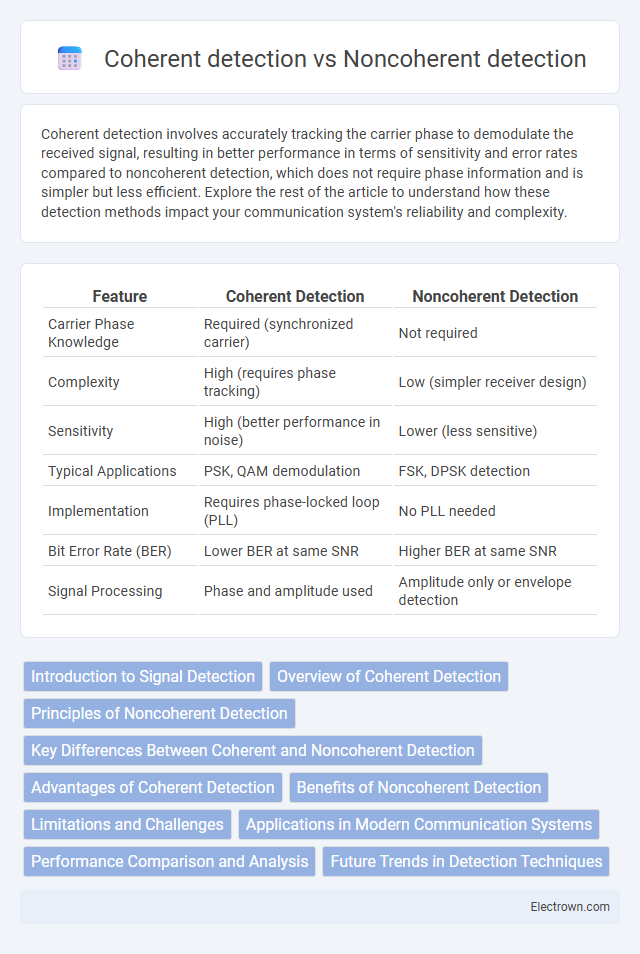Coherent detection involves accurately tracking the carrier phase to demodulate the received signal, resulting in better performance in terms of sensitivity and error rates compared to noncoherent detection, which does not require phase information and is simpler but less efficient. Explore the rest of the article to understand how these detection methods impact your communication system's reliability and complexity.
Table of Comparison
| Feature | Coherent Detection | Noncoherent Detection |
|---|---|---|
| Carrier Phase Knowledge | Required (synchronized carrier) | Not required |
| Complexity | High (requires phase tracking) | Low (simpler receiver design) |
| Sensitivity | High (better performance in noise) | Lower (less sensitive) |
| Typical Applications | PSK, QAM demodulation | FSK, DPSK detection |
| Implementation | Requires phase-locked loop (PLL) | No PLL needed |
| Bit Error Rate (BER) | Lower BER at same SNR | Higher BER at same SNR |
| Signal Processing | Phase and amplitude used | Amplitude only or envelope detection |
Introduction to Signal Detection
Coherent detection requires precise knowledge of the carrier phase and frequency, enabling demodulation by correlating the received signal with a locally generated reference signal, leading to improved sensitivity and lower error rates in communication systems. Noncoherent detection, in contrast, does not rely on phase information and instead detects the signal based on its envelope or energy, simplifying receiver design but generally resulting in higher bit error rates. The trade-off between complexity and performance defines the choice of detection method in applications such as wireless communication, radar, and optical systems.
Overview of Coherent Detection
Coherent detection involves phase synchronization between the received signal and a local oscillator, enabling accurate demodulation of phase-encoded signals such as PSK and QAM. This method provides higher sensitivity and improved bit error rate performance compared to noncoherent detection, making it ideal for applications requiring precise signal recovery. Coherent detection systems rely on phase-locked loops or pilot signals to maintain carrier phase alignment.
Principles of Noncoherent Detection
Noncoherent detection operates by identifying signals without requiring exact knowledge of the carrier phase, relying on signal envelope or energy measurements instead. This method simplifies receiver design and enhances robustness in environments with phase noise or rapid phase variations. Your communication system benefits from noncoherent detection in scenarios demanding low-complexity, reliable signal interpretation without complex phase synchronization.
Key Differences Between Coherent and Noncoherent Detection
Coherent detection requires exact knowledge of the carrier phase and frequency, enabling higher sensitivity and improved bit error rate performance in communication systems. Noncoherent detection operates without phase information, relying on energy or envelope detection, which simplifies receiver design but generally results in lower detection accuracy. The choice between coherent and noncoherent detection depends on system complexity, synchronization requirements, and performance trade-offs in wireless communication applications.
Advantages of Coherent Detection
Coherent detection offers superior sensitivity and improved signal-to-noise ratio by utilizing precise phase information of the carrier signal, enabling more accurate demodulation of complex modulation schemes such as QAM and PSK. It supports higher data rates and enhances spectral efficiency, making it ideal for advanced communication systems. Additionally, coherent detection provides better tolerance to interference and channel impairments compared to noncoherent detection, leading to more reliable signal recovery in noisy environments.
Benefits of Noncoherent Detection
Noncoherent detection offers significant benefits such as reduced receiver complexity and improved robustness against phase noise and frequency offset, making it ideal for systems where phase synchronization is challenging. It enables efficient signal detection without requiring exact carrier phase information, which lowers implementation costs and power consumption. Your communication system can achieve reliable performance in fading environments and dynamic channel conditions by leveraging noncoherent detection techniques.
Limitations and Challenges
Coherent detection requires precise phase synchronization between the transmitter and receiver, making it highly sensitive to phase noise and Doppler shifts, which complicates implementation in fast-fading or high-mobility environments. Noncoherent detection eliminates the need for exact phase information, but this advantage comes with reduced sensitivity and a higher bit error rate, limiting its performance in low signal-to-noise ratio (SNR) conditions. Understanding these limitations helps you choose the appropriate detection scheme based on your system's mobility, complexity, and accuracy requirements.
Applications in Modern Communication Systems
Coherent detection is essential in high-speed fiber-optic communication and advanced modulation schemes like PSK and QAM, offering superior sensitivity and spectral efficiency by using a synchronized local oscillator for phase information recovery. Noncoherent detection finds widespread use in simpler systems such as frequency-shift keying (FSK) in wireless sensor networks and low-power IoT devices, where robustness and reduced complexity outweigh the need for phase tracking. Modern communication systems often balance these methods to optimize performance, using coherent detection for high-capacity backbone links and noncoherent schemes in resource-constrained environments.
Performance Comparison and Analysis
Coherent detection offers superior performance in terms of bit error rate (BER) due to its phase synchronization capability, enabling accurate signal demodulation in scenarios with high signal-to-noise ratios (SNR). Noncoherent detection, while simpler and more robust against phase variations, generally exhibits higher BER and reduced sensitivity, making it suitable for environments with rapid phase fluctuations or limited channel knowledge. Comparative analysis reveals that coherent detection achieves optimal sensitivity and spectral efficiency at the cost of increased receiver complexity, contrasting with the lower complexity and resilience of noncoherent schemes under challenging channel conditions.
Future Trends in Detection Techniques
Future trends in detection techniques emphasize advanced coherent detection methods leveraging machine learning algorithms and digital signal processing for improved sensitivity and accuracy in complex environments. Noncoherent detection continues to evolve with adaptive thresholding and robust modulation schemes to enhance performance under low signal-to-noise ratios and sparse channel conditions. Integration of hybrid detection frameworks combining coherent and noncoherent elements is gaining momentum to optimize trade-offs in power consumption and detection reliability for next-generation wireless communication systems.
Coherent detection vs Noncoherent detection Infographic

 electrown.com
electrown.com